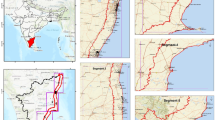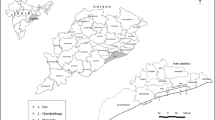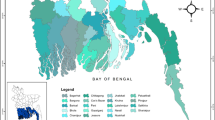Abstract
The coastal area supports millions of population in terms of livelihood, settlement and social activities across the world and India. The increasing rate of socioeconomic activities made the coasts susceptible to various hazards. Therefore, this study is aimed to examine the coastal vulnerability of Vishakhapatnam Coastal district using remote sensing and geographic information system. To fulfill this objective, six physical indicators, i.e., geomorphology, land use/land cover, coastal slope, shoreline change rate, etc., were prepared using the multi-temporal datasets of 1991, 2001, 2011 and 2018 and mean tidal height has been considered to calculate the coastal vulnerability index (CVI). The indicators selected for the analysis of coastal vulnerability have been integrated using the rank and weighted methods. The shoreline change has been detected using the digital shoreline analysis system (DSAS). Analytical hierarchy process (AHP) has been used for calculating weights of various indices. The CVI values obtained using different indicators are 2.6 (min) and 14.39 (max). Based on the CVI values, the coast is classified as five classes of vulnerability, i.e., very low (0—4.9) covering 42.5 km, low (4.9—7.3) which covers 29.49 km, moderate (7.3—9.6) covering 23.46 km, high (9.6—12.0) which covers 34.61 km, and very high (12.0–14.39) covering 7.5 km. This integrated study is found useful for exploring the accretion and erosion processes and also for vulnerability mapping in the coastal tract of Vishakhapatnam district.









Similar content being viewed by others
References
Antwi, E., Boakye-Danquah, J., Barima Owusu, A., Loh, S., Mensah, R., Boafo, Y., & Apronti, P. (2015). Community vulnerability assessment index for flood prone savannah agro-ecological zone: A case study of wa west district, Ghana. Weather and Climate Extremes, 10, 56–69.
Balica, S. F., Wright, N. G., & Meulen, F. V. D. (2012). A flood vulnerability index for coastal cities and its use in assessing climate change impacts. Natural Hazards, 64(1), 73–105.
Bama, V. P. S., Rajakumari, S., & Ramesh, R. (2020). Coastal vulnerability assessment of Vedaranyam swamp coast based on land use and shoreline dynamics. Natural Hazards. https://doi.org/10.1007/s11069-019-03844-5
Barnard, P., Erikson, L., Foxgrover, A., Hart, J., Limber, P., O’Neill, A., et al. (2019). Dynamic flood modeling essential to assess the coastal impacts of climate change. Scientific Reports, 9(1), 4309.
Bukvic, A., Rohat, G., Apotsos, A., & de Sherbinin, A. (2020). A systematic review of coastal vulnerability mapping. Sustainability, 12(7), 2822.
Census of India (2011). District Census Handbook Visakhapatnam. https://censusindia.gov.in/2011census/dchb/2813_PART_B_DCHB_VISAKHAPATNAM.pdf. Accessed May 2020.
Ciurean, R.L., Schroeter, D., Glade, T., (2013). Conceptual frameworks of vulnerability assessments for natural disasters reduction. In: Tiefenbacher J (eds.) Approaches to disaster management e examining the implications of hazards, emergencies and disasters. InTech, Rijeka, pp 3–32. https://cdn.intechopen.com/pdfswm/42656.pdf. Accessed April 2020.
Cutter, S. L., Boruff, B. J., & Lynn Shirley, W. (2003). Social vulnerability to environmental hazards. Social Science Quarterly, 84, 242–261.
Dhiman, R., VishnuRadhan, R., Eldho, T. I., & Inamdar, A. (2019). Flood risk and adaptation in Indian coastal cities: recent scenarios. Applied Water Science, 9, 5. https://doi.org/10.1007/s13201-018-0881-9
Diez, P. G., Perillo, G. M. E., & Piccolo, M. C. (2007). Vulnerability to sea-level rise on the coast of Buenos Aires province. J Coast Res., 23, 119–126.
Dolan, R., Hayden, B., May, P., & May, S. (1980). The reliability of shoreline change measurements from aerial photographs. Shore and Beach, 48, 22–29.
Ghosh, P. K., & Datta, D. (2012). Coastal tourism and beach sustainability—An assessment of community perceptions in Kovalam India. Geografia-Malaysian Journal of Society and Space, 8(7), 75–87.
Ghoussein, Y., Mhawej, M., Jaffal, A., Fadel, A., El Hourany, R., & Faour, G. (2018). Vulnerability assessment of the South-Lebanese coast: A GIS-based approach. Ocean & Coastal Management, 158, 56–63.
Goharnejad, H., Shamsai, A., & Hosseini, S. (2013). Vulnerability assessment of southern coastal areas of Iran to sea level rise: evaluation of climate change impact. Oceanologia, 55(3), 611–637.
Gornitz, V. (1991). Global coastal hazards from future sea level rise. Palaeogeography, Palaeoclimatology, Palaeoecology, 89(4), 379–398.
Guillard-Gonçalves, C., & Zêzere, J. (2018). Combining social vulnerability and physical vulnerability to analyse landslide risk at the municipal scale. Geosciences, 8(8), 294.
INCOIS (2012). Coastal vulnerability Atlas of India. Hyderabad: Indian National Centre for Ocean Information Services. https://incois.gov.in/portal/cvi/index.html. Accessed September 2020.
IPCC (2014). Drivers, Trends and Mitigation. Climate Change 2014 Mitigation of Climate Change. https://www.ipcc.ch/report/ar5/wg3/drivers-trends-and-mitigation/. Accessed June 2020
Islam, M. A., Mitra, D., Dewan, A., & Akhter, S. H. (2016). Coastal multi-hazard vulnerability assessment along the Ganges deltaic coast of Bangladesh–A geospatial approach. Ocean and Coastal Management, 127, 1–15.
ISRO, (2012). Indian Space Research Organisation (ISRO) Coastal Zones of India (Sponsored by Ministry of Environment & Forests, Govt. of India) [Ebook]. Ahmedabad. https://keralaczma.gov.in/pdfs/Coastal_Zones_of_India.pdf. Accessed May 2020).
Ju, C. Y., Jia, Y. G., Shan, H. X., Tang, C. W., & Ma, W. J. (2012). GIS-based coastal area suitability assessment of geo-environmental factors in Laoshan district, Qingdao. Natural Hazards and Earth System Sciences, 12(1), 143–150.
Kamphuis, J. W. (2010). Introduction to coastal engineering and management (2nd ed.). Singapore: World Scientific Publishing Co.
Kantamaneni, K., Sudha Rani, N. N. V., Rice, L., Sur, K., et al. (2019). A systematic review of coastal vulnerability assessment studies along Andhra Pradesh, India: A critical evaluation of data gathering, risk levels and mitigation strategies. Water, 11(2), 393.
Kantamaneni, K., Gallagher, A., & Du, X. (2019). Assessing and mapping regional coastal vulnerability for port environments and coastal cities. Journal of Coastal Conservation, 23, 59–70.
Koroglu, A., Ranasinghe, R., Jiménez, J., & Dastgheib, A. (2019). Comparison of Coastal Vulnerability Index applications for Barcelona Province. Ocean and Coastal Management, 178, 104799.
Krishnamurthy, R. R., DasGupta, R., Chatterjee, R., & Shaw, R. (2014). Managing the Indian coast in the face of disasters & climate change: A review and analysis of India’s coastal zone management policies. Journal of coastal conservation, 18(6), 657–672.
Krishna, G., Paul, N. C., Pradhan, S., Ahmad, T., & Sahoo, P. M. (2018). Spatiotemporal change detection of coastline with satellite remote sensing for environmental management. Journal of the Indian Society of Agricultural Statistics, 72(3), 205–211.
Kumar, K. S. K., & Tholkappian, S. (2006). Relative vulnerability of indian coastal districts to sea-level rise and climate extremes. International Review for Environmental Strategies, 6(1), 3–22.
Leo, F. D., Besio, G., Zolezzi, G., & Bezzi, M. (2019). Coastal vulnerability assessment: Through regional to local downscaling of wave characteristics along the Bay of Lalzit (Albania). Natural Hazards and Earth System Sciences, 19(1), 287–298.
Li, S., Dragicevic, S., Castro, F., Sester, M., Winter, S., Coltekin, A., et al. (2016). Geospatial big data handling theory and methods: A review and research challenges. ISPRS Journal of Photogrammetry and Remote Sensing, 115, 119–133.
Maanan, M., Maanan, M., Rueff, H., Adouk, N., Zourarah, B., & Rhinane, H. (2018). Assess the human and environmental vulnerability for coastal hazard by using a multi-criteria decision analysis. Human and Ecological Risk Assessment: An International Journal, 24(6), 1642–1658.
Madricardo, F., Foglini, F., Campiani, E., Grande, V., Catenacci, E., Petrizzo, A., et al. (2019). Assessing the human footprint on the sea-floor of coastal systems: The case of the Venice Lagoon. Italy. Scientific Reports, 9(1), 6615.
Martins, K., de Souza, P. P., Silva-Casarín, R., & Neto, A. (2017). The influence of climate change on coastal erosion vulnerability in Northeast Brazil. Coastal Engineering Journal, 59(2), 1740007-1-17400072–5.
McCarthy, J. J., Canziani, O., Leary, N. A., Dokken, D. J., White, K. S., (eds) (2001). Climate change 2001: impacts, adaptation and vulnerability. IPCC working group II. Cambridge University Press, Cambridge. https://library.harvard.edu/collections/ipcc/docs/27_WGIITAR_FINAL.pdf. Accessed September 2020.
Mclaughin, S., & Cooper, J. A. G. (2010). A multi-scale coastal vulnerability index: A tool for coastal managers? Environmental Hazards, 9(3), 233–248.
Murali, R. M., Ankita, M., Amrita, S., & Vethamony, P. (2013). Coastal vulnerability assessment of Puducherry coast, India, using the analytical hierarchical process. Natural Hazards and Earth System Sciences, 13(12), 3291–3311.
Murali, R. M., Riyas, M. J., Reshma, K. N., & Kumar, S. S. (2019). Climate change impact and vulnerability assessment of Mumbai city, India. Natural Hazards, 102, 575–589.
NCCR (2018). National Assessment of Shoreline Changes along Indian Coast, Status Report. Ministry of earth Sciences, National Centre for Coastal Research (NCCR), Chennai. https://www.nccr.gov.in/sites/default/files/schangenew.pdf. Accessed March 2020.
NDSAP (2012). National Data Sharing and Accessibility Policy-2012 (NDSAP-2012), Department of Science and Technology, Ministry of Science and Technology, Government of India. https://geoportal.mp.gov.in/geoportal/Content/Policies/NDSAP_2012.pdf. Accessed August 2020).
Neumann, B., Ott, K., & Kenchington, R. (2017). Strong sustainability in coastal areas: a conceptual interpretation of SDG 14. Sustainability Science, 12(6), 1019–1035.
O’Brien, K., Leichenko, R., Kelkar, U., Venema, H., et al. (2004). Mapping vulnerability to multiple stressors: Climate change and globalization in India. Global Environmental Change, 14(4), 303–313.
Pantusa, D., D’ Alessandro, F., Riefolo, L., Principato, F., & Tomasicchio, G. (2018). Application of a coastal vulnerability index a case study along the apulian coastline Italy. Water, 10(9), 1218.
Parthasarathy, A., & Natesan, U. (2014). Coastal vulnerability assessment: a case study on erosion and coastal change along Tuticorin. Gulf of Mannar Natural Hazards, 75(2), 1713–1729.
Parthasarathy, K. S. S., & Deka, P. C. (2019). Remote sensing and GIS application in assessment of coastal vulnerability and shoreline changes: A review. ISH Journal of Hydraulic Engineering, 14, 1–13.
Pendleton, E. A., Thieler, E. R., Williams, S. J., Beavers, R. S., (2004). Coastal vulnerability assessment of Padre Island National Seashore (PAIS) to sea-level rise. USGS report No 2004–1090. https://pubs.er.usgs.gov/publication/ofr20041090. Accessed March 2020.
Pollard, J. A., Spencer, T., & Brooks, S. M. (2019). The interactive relationship between coastal erosion and flood risk. Progress in Physical Geography, 43(4), 574–585.
Prakash, S., Sharma, M. C., Kumar, R., Dhinwa, P. S., Sastry, K. L. N., & Rajawat, A. S. (2016). Mapping and assessing land degradation vulnerability in Kangra district using physical and socio-economic indicators. Spatial Information Research, 24, 733–744.
Pramanik, M. K., Biswas, S. S., Mondal, B., & Pal, R. (2016). Coastal vulnerability assessment of the predicted sea level rise in the coastal zone of Krishna-Godavari delta region, Andhra Pradesh, east coast of India. Environment, Development and Sustainability, 18(6), 1635–1655.
Praveen, B., Talukdar, S., ShahfahadMahato, S., Mondal, J., Sharma, P., Islam, A. R. M. T., & Rahman, A. (2020). Analyzing trend and forecasting of rainfall changes in India using non-parametrical and machine learning approaches. Scientific Reports, 10, 10342.
Rahman, A., Kumar, Y., Fazal, S., & Bhaskaran, S. (2011). Urbanization and quality of urban environment using remote sensing and gis techniques in East Delhi-India. Journal of Geographic Information System, 03(01), 62–84.
Rani, N. N. V. S., Satyanarayana, A. N. V., & Bhaskaran, P. K. (2015). Coastal vulnerability assessment studies over India: A review. Natural Hazards, 77, 405–428.
Rao, K. N., Subraelu, P., Rao, T. V., Malini, B. H., Ratheesh, R., Bhattacharya, S., & RajawatAjai, A. S. (2008). Sea-Level rise and coastal vulnerability: An assessment of andhra pradesh coast, india through remote sensing and GIS. Journal of Coastal Conservation, 12(4), 195–207.
Rehman, S., Sahana, M., Kumar, P., & Ahmed sajjad, R. H. (2020). Assessing hazards induced vulnerability in coastal districts of India using site-specific indicators: an integrated approach. GeoJournal. https://doi.org/10.1007/s10708-020-10187-3
Rincón, D., Khan, U., & Armenakis, C. (2018). Flood risk mapping using gis and multi-criteria analysis: A greater toronto area case study. Geosciences, 8(8), 275.
Rocha, C., Antunes, C., & Catita, C. (2020). Coastal vulnerability assessment due to sea level rise: The case study of the atlantic coast of mainland portugal. Water, 12(2), 360.
Ružić, I., Dugonjić Jovančević, S., Benac, Č, & Krvavica, N. (2019). Assessment of the coastal vulnerability index in an area of complex geological conditions on the Krk Island. Northeast Adriatic Sea. Geosciences, 9(5), 219.
Satta, A., Puddu, M., Venturini, S., & Giupponi, C. (2017). Assessment of coastal risks to climate change related impacts at the regional scale: The case of the Mediterranean region. International Journal of Disaster Risk Reduction, 24, 284–296.
Saaty, T. L., Vargas, L. G. (1991). Prediction, projection and forecasting (p. 251). Dordrecht: Kluwer Academic Publisher. https://doi.org/10.1007/978-94-015-7952-0.
Saaty, T. L. (1977). A scaling method for priorities in hierarchical structures. Journal of Mathematical Psychology, 15(3), 234–281.
Saaty, T. L. (2008). Decision making with the analytic hierarchy process. Int J Serv Sci, 1(1), 83–98.
Sankari, T., Chandramouli, A., Gokul, K., Surya, S., & Saravanavel, J. (2015). Coastal vulnerability mapping using geospatial technologies in Cuddalore-Pichavaram coastal tract, Tamil Nadu, India. Aquatic Procedia, 4, 412–418.
Serio, F., Armenio, E., Mossa, M., & Petrillo, A. (2018). How to define priorities in coastal vulnerability assessment. Geosciences, 8(11), 415.
Sterzel, T., Lüdeke, M. K. B., Walther, C., Kok, M. T., Sietz, D., & Lucas, P. L. (2020). Typology of coastal urban vulnerability under rapid urbanization. PLoS ONE, 15(1), e0220936. https://doi.org/10.1371/journal.pone.0220936.
Thieler, R. E., Hammar-Klose, E. S. (2000). National assessment of coastal vulnerability to sea-level rise: preliminary results for the US Pacific Coast. US Geological Survey. https://pubs.er.usgs.gov/publication/ofr00178. Accessed March 2020.
UNEP (2005). Assessing Coastal Vulnerability: Developing a Global Index for Measuring Risk. UNEP. Nairobi, Kenya.https://www.scribd.com/document/330492777/Assessing-Coastal-Vulnerability-Developing-a-Global-Index-for-Measuring-Risk. Accessed March 2020.
Vinuesa, R., Azizpour, H., Leite, I., Balaam, M., Dignum, V., Domisch, S., et al. (2020). The role of artificial intelligence in achieving the sustainable development goals. Nature Communications, 11, 233.
Vivek, G., Mahendra, R. S., Mohanty, P. C., Srinivasa Kumar, T., & Nanda, S. (2016). Coastal vulnerability assessment for North East Coast of Andhra Pradesh, India. International Journal of Remote Sensing and Geoscience (IJRSG), 5(2), 1–7.
Williams, A., Rangel-Buitrago, N., Pranzini, E., & Anfuso, G. (2018). The management of coastal erosion. Ocean and Coastal Management, 156, 4–20. https://doi.org/10.1016/j.ocecoaman.2017.03.022
Woodworth, P. L., Melet, A., Marcos, M., et al. (2019). Forcing factors affecting sea level changes at the coast. Surveys in Geophysics, 40, 1351–1397.
Yang, R., Wu, Y., Hwung, H., Liou, J., & Shugan, I. (2010). Current countermeasure of beach erosion control and its application in Taiwan. Ocean & Coastal Management, 53(9), 552–561. https://doi.org/10.1016/j.ocecoaman.2010.06.018
Acknowledgement
The lead and the third author of this study are thankful to Indian Council of Social Science Research (ICSSR) for providing the Doctoral Research Fellowship during this research work. The authors also thank Unites States Geological Survey (USGS) for providing Landsat data freely accessible and General Bathymetric Chart of the Oceans (GEBCO) for making the data freely available to be used.
Author information
Authors and Affiliations
Corresponding author
Ethics declarations
Conflict of Interest
There is no conflict of interest on any issue among the authors.
Additional information
Publisher's Note
Springer Nature remains neutral with regard to jurisdictional claims in published maps and institutional affiliations.
About this article
Cite this article
Baig, M.R.I., Shahfahad, Ahmad, I.A. et al. Coastal Vulnerability Mapping by Integrating Geospatial Techniques and Analytical Hierarchy Process (AHP) along the Vishakhapatnam Coastal Tract, Andhra Pradesh, India. J Indian Soc Remote Sens 49, 215–231 (2021). https://doi.org/10.1007/s12524-020-01204-6
Received:
Accepted:
Published:
Issue Date:
DOI: https://doi.org/10.1007/s12524-020-01204-6




